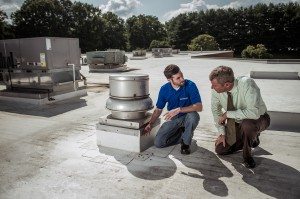Good roof preventative maintenance practices include semiannual inspections.
For most of us, September 23rd, the first day of fall, ushers in lower temperatures, changing leaves and tailgating. But did you know this is the best time of year to be proactive and have your bi-annual roof inspection done? While today’s roofing systems are durable and much more resilient than they were 10 years ago, neglecting fall roof preventative maintenance can lead to premature roof failure. For the best insurance against the high replacements costs associated with damaged roofing systems, the commercial roofing industry recommends semiannual inspections and maintenance.
During the summer months, intense UV rays, torrential downpours and strong winds can wreak havoc on a roof. Even the strongest roofs can be damaged or become victims to the elements. By performing a fall audit of your roof’s condition, you can identify existing roof issues and repair them prior to going into the winter months. This increases the life of your roof which can translate into big financial savings for you. Because small problems aren’t always apparent to the untrained eye – it is best practices to have a knowledgeable roofing professional perform the fall survey.
Typical Fall Roof Preventative Maintenance and Inspections
The typical fall survey includes a visual check of the interior ceiling and walls for water staining, followed by a careful rooftop examination of cap and base flashings, edge metal, roof adhesives and penetrations. The field of the roof is examined and ballast or roof coatings (if applicable) are inspected for integrity. The inspector is looking for loose flashing, missing fasteners, displaced or deformed metal, corrosion, seam integrity, secure terminations and signs of deteriorating sealants.
Penetrations are carefully inspected to ensure that they will withstand freezing rain, snow and ice formation without leaking. Any moisture compromises a roof’s insulation layer, rendering it ineffective and contributing to increased energy costs. Over the winter, moisture that enters a small leak can freeze and expand, increasing the size of the leak, leading to moisture entrapment and possibly damaging the roof structure beneath. Left unchecked, it can also contribute to mold growth, premature deterioration of the roof system and potential damage to the facility’s contents.
During a standard inspection, a skilled roofing professional will examine the roof system and all roof components. This is the time to make simple repairs and perform necessary maintenance to get your facility through the winter safely. In addition to repairing any problems discovered during the inspection, a good roofing professional will clear the roof of debris and make sure that the drainage system is free from clogs and that it is functioning correctly.
Preparation is the key.
There’s still time to get your fall roof inspection completed. Don’t wait until Jack Frost is nipping at your nose to think about making sure your roof is in good condition. Give North American Roofing a call. . We’ll do a thorough inspection of your facility’s roofing system and help you take the correct steps to protect it during this coming winter season and for years to come. By making the call today, you’ll not only save on winter energy costs, you’ll reduce the demand on your heating units as well.

